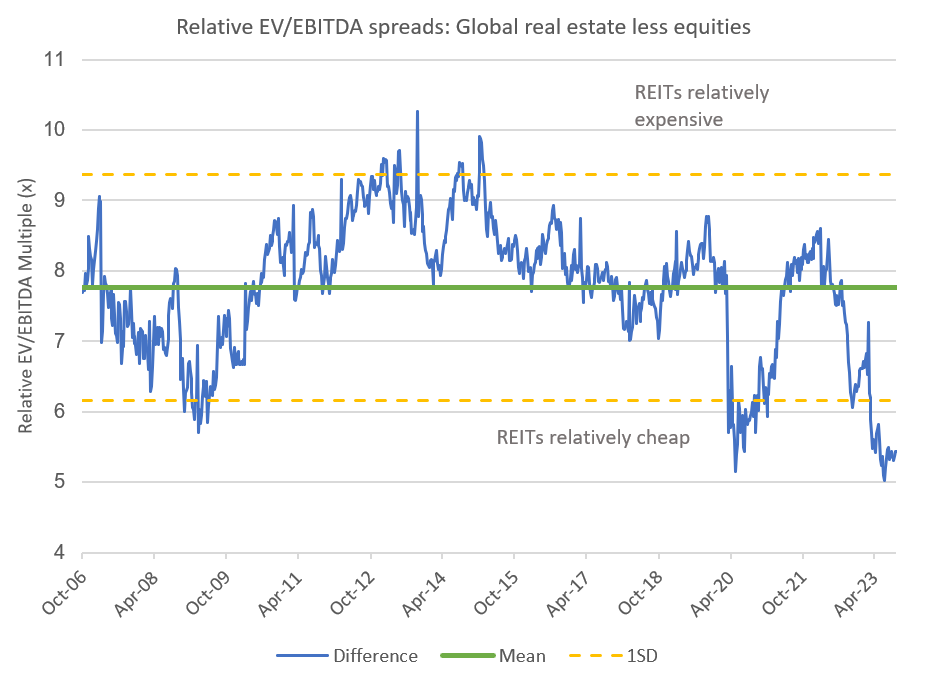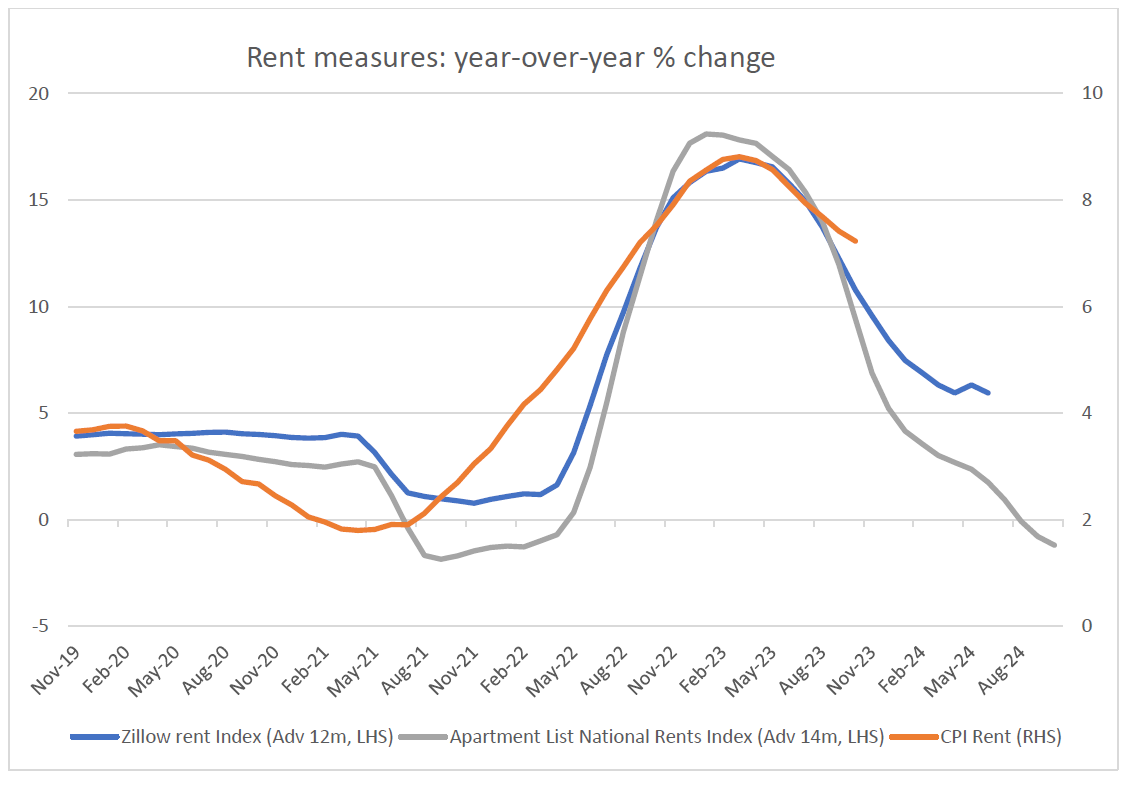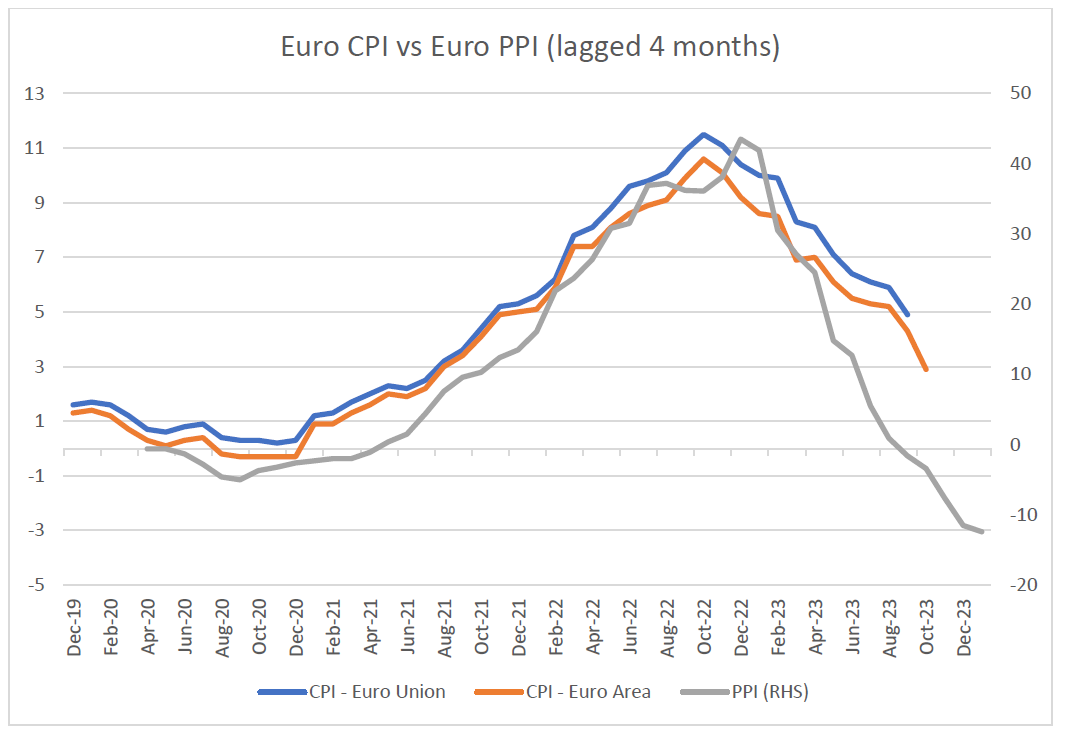Relative to equities, global real estate has rarely been this cheap

Source: Bloomberg, Quay Global Investors
What it means
The chart depicts the simple difference between the expected EBITDA (earnings before interest, tax, depreciation and amortization) between global equities and global real estate. The lower the number, the less expensive real estate screens relative to equities.
The chart explains the recent underperformance of the real estate asset class is less about operating fundamentals and more a story about macroeconomic factors, asset allocation and sentiment.
When is the right time to re-allocate?
As most Australian observers of the domestic residential market have discovered, a turnaround in sentiment and pricing does not always need a change in interest rate outlook. Right now, the sector is as (relatively) cheap as it has ever been over the past 18 years.
US housing and rental cost deflation is coming

Source: Bloomberg, Zillow, Apartment Association, Quay Global Investors
What it means
US inflation continues to climb down from the elevated levels of mid-2022. Some of this deceleration is helped by falling rental costs.
As we highlighted in our recent Investment Perspectives article, A big disinflation tailwind is coming, there is a lag between actual rental inflation and the data that feeds into the monthly CPI.
The chart above has been updated for recent data with the known private data set forward to adjust for the known ~12 month lag, and highlights the deceleration that is coming over the next few months. As predicted in our previous article, the BLS inflation data continues to track the forward private sector data. Eventually, the decline in housing costs will cut roughly two percentage points from the headline CPI (currently 3.2%) data into 2024. It’s no wonder there is a growing consensus that the “Fed is done”[1].
Deflation coming to Europe?

Source: Eurostat, Quay Global Investors
What it means
Not unlike the rest of the world, Europe suffered a significant increase in inflation post pandemic. Also, like the rest of the word, it was clear the inflation was largely driven by supply chain issues and was transitory.
One area Europe differs from most other western markets, is the fiscal response during the pandemic (10% of GDP) was not as large as the US (~25%), Australia (~17%), or Japan (~15%)[2]. As economies and supply chains normalize, there is a clear lack of aggregate demand such that the producer price index (PPI), a leading index for the CPI (see chart above), is now running at a deflationary low of -12.4%. That’s not a misprint. It’s minus 12.4%.
Along with weak economic growth and job losses, it seems reasonable to expect interest rate cuts into 2024.
Has online retail penetration peaked?

Source: ABS, Quay Global Investors
What it means
With the pandemic well in the rear-view mirror, it seems the gain in share from online retail has stalled. Using ABS data for online retail sales, the share of total sales now sits at around 10% - a figure in line after the end of the first lockdown in 2020.
Worryingly for the e-commerce thesis, more recent data shows a significant drop in online sales, as bricks and mortar now appear to be gaining share. For example, in the three months to September 2023, Scentre Group (Australia’s largest Mall owner/manager) recorded retail sales growth of +3%[3], compared to national sales’ growth of 2.1%.
No wonder industrial landlords now want to talk about data centers[4].
A wave of supply for industrial property supply is coming

Source: JLL, Quay Global Investors
What it means
At a time where online retail penetration is potentially peaking, record amounts of new supply of industrial property is under construction. In fact, in the US, third quarter deliveries of new industrial property exceeded 170m square feet, just shy of the full year deliveries in 2019. To date, more than 450m square feet have been delivered in 2023, up 23.5% on the record set in 2022[5].
For the past 10 years, industrial property was the “go-to” sector for specialists and generalists alike. To us, valuations and the overall theme look increasingly vulnerable.
Artificial intelligence (AI) opportunities in real estate may be in the last place you expect

Source: JLL research, Bloomberg, Quay Global Investors
What it means
Great investment themes always feel compelling, but ultimately, investors make returns from valuation. If you can get both right, then significant opportunities may be on offer.
In recent years, the San Fransisco office market has been the poster child for collapsing office values as vacancy rate soar past 30%, and some office values down 75% from peak[6].
However, there just may be a diamond in the rough. Today, 33 of the top 50 global AI companies (66%) are headquartered in the San Fransisco bay area[7]. And these companies require employees to work in the office[8], which in turn, is generating accelerating leasing demand as the above chart demonstrates.
It may take some time for the +30% vacancy to be absorbed, but it feels there are significant opportunities in San Francisco for the patient real estate investor.
The demographic time-bomb is already here….in Japan

Source: World data, Quay Global Investors
What it means
For the first time, each of Japan’s 47 prefectures posted a population decline in 2022. More the half of all municipalities in Japan are designated depopulation districts, schools are now closing, and more than 1.2 million small businesses have owners aged around 70 with no successors[9].
The implications for the local real estate industry (and potentially the banking sector) will be profound. Excess industry capacity (vacancy rate) is usually overcome with steady population growth; however this will not be the case in Japan.
The Japanese real estate market accounts for over 10% of the global listed real estate index (developed). This is a slow moving, but very big, story.
US household savings are on the rise, again

Source: US Federal Reserve (Z.1 accounts, line 49), Quay Global Investors
What it means
At the end of September, the Bureau of Economic Analysis updated its savings rate numbers and concluded that US “excess savings” during the pandemic are higher than previously believed[10]. As we detailed in our article from November 2021, Why the boom in household savings ain’t going away, one entity’s spending is always another’s income. So, when households spend, the income generally flows through to companies that pay wages and pay dividends from earned profits. Much of this simply flows back to households.
But now the rate of US household savings is growing again – adding a buffer to US household balance sheets. If there is any slow down or recession in the US, it seems unlikely to come from the household sector.
Where will all the cash go if interest rates fall?

Source: Bloomberg, Quay Global
What it means
Where are these aforementioned savings accumulating? Not just in the banks, but more than ever, in money market funds (which in turn invest in high grade T-bills and bonds).
In a world of +5% interest rates, this makes sense. But it also places the recent US equity market rally into impressive context – that there is a lot of investing firepower across a range of risk assets if or when interest rates begin to fall and cash begins to be re-invested again, as it did in 2009-2010.
Savings are supported by increasing US deficits

Source: US Federal Reserve (Z.1 accounts, line 50) , Quay Global Investors
What it means
How can the US economy remain in such good heath while households are increasing their savings?
As we have previously highlighted, the answer is usually found via the change in sectoral balances. In this case, the re-acceleration in US government deficit (supported by rising interest payments on government debt balances) is adding money to the non-government sector, supporting incomes, profits and growth. As one entity’s financial loss (government) is exactly offset by another’s gain (non-government sector), the expanding deficit via higher interest rates is good news for the US economy and bad news for investors betting on a recession.
The bad news is Australia is headed in the other direction

Source: ABS, Quay Global Investors
What it means
There have been recent signs of deceleration of the Australian economy. And while most will point to higher interest rates as the culprit, the federal government is playing its part via the fiscal balances.
The chart above highlights the near mirror image between federal government balances (net borrowing) and households (net lending). This should come as no surprise since the federal government’s so called “red ink” is equal to the non-government sector’s “black ink” simply by the laws of accounting.
As the current government lauds its attempt to deliver a “budget surplus”[11] the accounting reality is this will drain the non-government sector of much-needed net financial assets at a time of tight household budgets and elevated cost of borrowings.
If Australia does slide into recession in 2024, this will be a major cause.
US small banks are still lending to commercial real estate

Source: US Federal Reserve (H.8 Assets and liabilities), Quay Global Investors
What it means
Despite the near daily headlines of a predicted commercial lending crisis in the US post the Silicon Valley Bank collapse, US Federal Reserve data continues to point to positive credit expansion for most forms of commercial real estate (CRE). In fact, since the March banking crisis earlier this year, small US commercial banks (supposedly the most vulnerable) have extended a net $86.5 billion in additional commercial real estate credit.
As we highlighted in our article, Banks, balance sheets and bailouts earlier this year, commercial real estate includes a wide variety of asset classes, most of which continue to post positive growth in underlying cashflows, which enhances underlying credit quality. Office remains the challenged asset class, however, to date, overall credit continues to flow to the real estate sector.
A final brag…and thank you
As we close another year, as fund managers we often look back on our mistakes. What did we get wrong, and where could have we done better? This industry is quite efficient in assessing performance simply via the raw performance numbers. And on this basis, we feel we did ‘ok’, but can certainly do better.
We can however point with a certain amount of satisfaction to the quality and accuracy of our regularly published Investment Perspectives articles. And while this year’s economic and market environment may have surprised many, it has not surprised us. Our regular readers would have known, in advance, that:
- As per the Kalecki profit equation, US corporate profits were likely to remain robust post pandemic (as per our article published in June 2021);
- US interest rates would not slow the economy (as published in September 2022);
- A soft US economic landing was likely in 2023 (as published in December 2022);
- There were plenty of reasons to be optimistic in financial markets in 2023 (as published in February 2023);
- Australian residential property prices were likely to rise in 2023 (as published in March 2023);
- Concerns about the so-called “US banking crisis” were overblown (as published in April 2023);
- US disinflation was coming by year end (as published in September 2023);
Most of these views were non-consensus at the time. Most have turned out to be correct.
We always try to ensure our articles are of some value to our readers and strive to ensure our conclusions are backed by research, analysis and hard data. It’s this same rigor we apply to our stock analysis.
And a final year-end thanks to our investors and supporters. We take the responsibility of managing your money with the humility and gravity it deserves, and we continue to look forward to identifying the best research-backed global real estate opportunities into 2024.
[1] https://www.livemint.com/news/world/fed-is-done-raising-interest-rates-economists-say-11694464511805.html
[2] https://www.imf.org/en/Topics/imf-and-covid19/Fiscal-Policies-Database-in-Response-to-COVID-19
[3] https://www.scentregroup.com/investors/financial-results-and-presentations/third-quarter-operational-update
[4] https://www.afr.com/property/commercial/ai-drives-30b-data-centre-opportunity-at-goodman-20230817-p5dx6o
[5] https://www.globest.com/2023/10/05/industrial-sees-its-highest-level-of-deliveries-to-date/?slreturn=20230915200453
[6] https://www.independent.org/news/article.asp?id=14515
[7] Top 50 AI companies based on Forbes 2023 The AI 50 list. Source: Essex Property Trust
[8] https://www.bloomberg.com/news/articles/2023-11-15/ai-startups-are-a-bright-spot-in-san-francisco-s-dismal-office-market?Fds-Load-Behavior=force-external&embedded-checkout=true#xj4y7vzkg
[9] https://www.theguardian.com/world/2023/jul/26/japan-population-how-many-people-drops-first-time-births-deaths
[10] https://robbreport.com/lifestyle/finance/american-savings-economy-recession-1235333161/
[11] https://www.theguardian.com/business/2023/sep/22/federal-budget-surplus-jim-chalmers
The content contained in this article represents the opinions of the authors. The authors may hold either long or short positions in securities of various companies discussed in the article. This commentary in no way constitutes a solicitation of business or investment advice. It is intended solely as an avenue for the authors to express their personal views on investing and for the entertainment of the reader.
